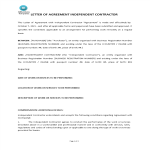Warning Letter To Contractor For Delay Of Work
Sponsored Link免费模板 保存,填空,打印,三步搞定!

Download Warning Letter To Contractor For Delay Of Work
微软的词 (.docx)免费文件转换
- 本文档已通过专业认证
- 100%可定制
- 这是一个数字下载 (27.95 kB)
- 语: English
Sponsored Link
How to draft a warning letter to a contractor for delay of work? What should I include in a warning letter to a contractor? This letter should detail the consequences of the contractor's delay, such as additional costs associated with the delay, as well as any lost time or revenue due to it. Download this sample template now, modify and use it as a guide in writing your own letter.
A warning letter to a contractor is a formal document issued by a client, project manager, or employer to address and document concerns, issues, or non-compliance with the terms of a contract or agreement. The purpose of such a letter is to officially communicate the problems, expectations, and potential consequences if the contractor does not resolve the issues or improve their performance. Warning letters are often part of the process of managing a contract and ensuring that both parties fulfill their obligations.
Key components typically included in a warning letter to a contractor are as follows:
- Date and Contact Information: The letter should start with the date of issuance and contact information for both the sender (the client or project manager) and the recipient (the contractor).
- Contract Details: Reference the relevant contract, agreement, or project by specifying its title, date of execution, and other pertinent details.
- Statement of Concern: Clearly and concisely state the reason for issuing the warning letter. Explain the specific issues, concerns, or breaches of contract that have led to the warning.
- Contractual Violations: Detail the sections, terms, or clauses of the contract that the contractor has allegedly violated or failed to meet. Provide specific examples and documentation, if possible.
- Expectations and Corrective Actions: Clearly outline the expectations and corrective actions required from the contractor to resolve the issues or non-compliance. Specify the timeframe within which these actions should be taken.
- Consequences: Describe the potential consequences if the contractor fails to address the issues or comply with the contract terms within the specified timeframe. This may include termination of the contract, financial penalties, or other actions.
- Compliance Deadline: Set a specific deadline by which the contractor is expected to rectify the issues or demonstrate compliance with the contract terms. This deadline should be reasonable and achievable.
- Contact Information: Provide contact information for the sender in case the contractor has questions or needs clarification.
- Formal Closing: Use a formal closing, such as "Sincerely" or "Yours faithfully," followed by the sender's signature and printed name.
- CC (Carbon Copy): If necessary, include a list of individuals or parties who will receive copies of the warning letter (CC), which may include legal representatives or higher management.
Warning letters to contractors is an important part of contract management and dispute resolution. They serve as a written record of the concerns, expectations, and potential consequences, which can be crucial in case of further disputes or legal actions. While the issuance of a warning letter is a serious step, it should be carried out in accordance with the terms of the contract and any applicable laws and regulations. It's important for both parties to address and resolve issues in a professional and transparent manner.
This template will perfectly suit your needs! And after downloading you can craft and customize every detail of its appearance very quickly.
DISCLAIMER
Nothing on this site shall be considered legal advice and no attorney-client relationship is established.
发表评论。 如果您有任何问题或意见,请随时在下面发布
相关文件
Sponsored Link



